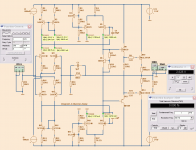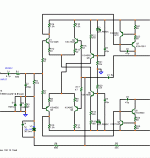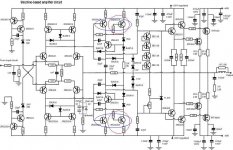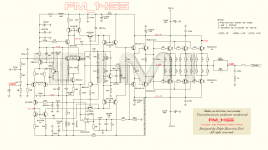Symmetrical dual differential input with 4 transistors.
Each input pair has one Mirror as load.
In order to set the VAS bias to 2 mA
I force out 4 uA into VAS transistor.
This is done by adjusting Mirror resistors, R2 / R25,
and set them to 988 Ohm instead of 1000 Ohm.
The amplifier works well in spice.
The distortion is low. Less than 0.001% at 1 Watt level.
But it is not ultralow, as this so far is a very basic circuit.
Anyway, THD 0.002% at 25 Watt into 8 Ohm is still good numbers.
(means 20 Vpeak and Supply is only 24 Volt)
Here is my question.
Will this method to bias VAS work in real amplifier?
I have my doubts.
Everything done in Sim, can not always be done in reality.
Each input pair has one Mirror as load.
In order to set the VAS bias to 2 mA
I force out 4 uA into VAS transistor.
This is done by adjusting Mirror resistors, R2 / R25,
and set them to 988 Ohm instead of 1000 Ohm.
The amplifier works well in spice.
The distortion is low. Less than 0.001% at 1 Watt level.
But it is not ultralow, as this so far is a very basic circuit.
Anyway, THD 0.002% at 25 Watt into 8 Ohm is still good numbers.
(means 20 Vpeak and Supply is only 24 Volt)
Here is my question.
Will this method to bias VAS work in real amplifier?
I have my doubts.
Everything done in Sim, can not always be done in reality.
Attachments
There s other methods to have steady vas currents
while retaining the current mirrors without having
to rely on statistics...
while retaining the current mirrors without having
to rely on statistics...
Looks like a tricky ballancing act.
Any drift (temperature) in the current mirror bias will effect the VAS bias. Try siming a 2% change in r2 or r25 (or one of the mirror transistor hfe ) and see what happens to the VAS bias.
Any drift (temperature) in the current mirror bias will effect the VAS bias. Try siming a 2% change in r2 or r25 (or one of the mirror transistor hfe ) and see what happens to the VAS bias.
Current mirrors at input pairs will create crazy high loop gain , may give rise to instability. Leach style is simpler , much more stable. (Below) The instability of the CM's and that VAS outweigh the sensibility and stability of the normal approach with very little , if any, sonic improvement.
OS
OS
Attachments
"Current mirrors at input pairs will create crazy high loop gain , may give rise to instability. Leach style is simpler , much more stable. (Below) The instability of the CM's and that VAS outweigh the sensibility and stability of the normal approach with very little , if any, sonic improvement."
I agree 100% with this. >80db OLG at 1KHz is easily acheivable with the Leach topology, its clean (no rail sticking), can be made damn fast (250Vus and symmetrical with front end filter removed) and 20KHz THD in the region of 20-50ppm with careful implementation. Who needs 1ppm when the speaker is typically 0.2 to 0.5%? Other than the intellectual challenge and joy of circuit gymnastics, mirror loaded fully balanced designs bring little to the party. Having said that, on a blameless, it does make some sense . . . but then the blameless has its own set of problems . . .
Pick your poison!
I agree 100% with this. >80db OLG at 1KHz is easily acheivable with the Leach topology, its clean (no rail sticking), can be made damn fast (250Vus and symmetrical with front end filter removed) and 20KHz THD in the region of 20-50ppm with careful implementation. Who needs 1ppm when the speaker is typically 0.2 to 0.5%? Other than the intellectual challenge and joy of circuit gymnastics, mirror loaded fully balanced designs bring little to the party. Having said that, on a blameless, it does make some sense . . . but then the blameless has its own set of problems . . .
Pick your poison!
"Current mirrors at input pairs will create crazy high loop gain , may give rise to instability. Leach style is simpler , much more stable. (Below) The instability of the CM's and that VAS outweigh the sensibility and stability of the normal approach with very little , if any, sonic improvement."
I agree 100% with this. >80db OLG at 1KHz is easily acheivable with the Leach topology, its clean (no rail sticking), can be made damn fast (250Vus and symmetrical with front end filter removed) and 20KHz THD in the region of 20-50ppm with careful implementation. Who needs 1ppm when the speaker is typically 0.2 to 0.5%? Other than the intellectual challenge and joy of circuit gymnastics, mirror loaded fully balanced designs bring little to the party. Having said that, on a blameless, it does make some sense . . . but then the blameless has its own set of problems . . .
Pick your poison!
It is good for lineup to experiment , I agree. That is why I go modular , I like to as do so as well. Amp above is making somebody money now , running 6 OP pairs at 70V rails. It only drives big DJ speakers , but is reliable. my only issue with this topology is it's tendency to cancel out even order harmonics. when it does get distortion , it's all odd (H3,5,7,9).. sounds harsh.
OS
Hi Lineup,
You not can use current mirrors in this way in a double differential pair. DC bias is different from an amp with a single differential pair, but you can use the mirror if compensate the base.
I have no experience with double symmetrical pair, only can indicate a link.
http://sites.mpc.com.br/albuquerque/dicas/fm1450/fm1450.gif
You not can use current mirrors in this way in a double differential pair. DC bias is different from an amp with a single differential pair, but you can use the mirror if compensate the base.
I have no experience with double symmetrical pair, only can indicate a link.
http://sites.mpc.com.br/albuquerque/dicas/fm1450/fm1450.gif
current mirrors do enable higher loop gain - at low frequency, with 2-pole compensation - high frequency stability is easily "restored" by simply adjusting Cdom for safe gain intercept frequency with the increased input stage gm
the bias instability is entirely common mode - a common mode bias regulation loop can be added to the complementary diff pair + currrent mirror input with almost no interaction with the global (differential) feedback loop
http://www.diyaudio.com/forums/solid-state/56860-optoisolator-vas-bias-comp-diff.html#post637347
the bias instability is entirely common mode - a common mode bias regulation loop can be added to the complementary diff pair + currrent mirror input with almost no interaction with the global (differential) feedback loop
http://www.diyaudio.com/forums/solid-state/56860-optoisolator-vas-bias-comp-diff.html#post637347
Last edited:
Yes, the main reason for current mirrors (or current sources, as a mirror is type a CCS)current mirrors do enable higher loop gain - at low frequency, with 2-pole compensation - high frequency stability is easily "restored" by simply adjusting Cdom for safe gain intercept frequency with the increased input stage gm
the bias instability is entirely common mode - a common mode bias regulation loop can be added to the complementary diff pair + currrent mirror input with almost no interaction with the global (differential) feedback loop
http://www.diyaudio.com/forums/solid-state/56860-optoisolator-vas-bias-comp-diff.html#post637347
is to increase gain.
If we have higher gain in each stage (and especially the first stages)
we can can make more simple amplifiers with less many gain-stages/transistors.
http://www.diyaudio.com/forums/solid-state/56860-optoisolator-vas-bias-comp-diff.html#post637347
jcx
Thanks for that topic.
I see you have been into this issue
and tried to find solutions.
And I know from before you are a clever guy with good amplifier knowledge.
Regards Lineup
Symmetrical dual differential input with 4 transistors.
[snip]
Here is my question.
Will this method to bias VAS work in real amplifier?

edit: see also: http://www.diyaudio.com/forums/solid-state/16796-unstable-vas-current-amp-slone-book.html#post195526
I have my doubts.
Everything done in Sim, can not always be done in reality.

current mirrors do enable higher loop gain - at low frequency, with 2-pole compensation - high frequency stability is easily "restored" by simply adjusting Cdom for safe gain intercept frequency with the increased input stage gm

the bias instability is entirely common mode - a common mode bias regulation loop can be added to the complementary diff pair + currrent mirror input with almost no interaction with the global (differential) feedback loop
http://www.diyaudio.com/forums/solid-state/56860-optoisolator-vas-bias-comp-diff.html#post637347

Last edited:
This Stochino fast amplifier uses mirrors in symmetrical diff input.
The coupling to VAS makes me all dizzy.
Hard to see how it all works ....
The output is IRF640/IRF9640
The coupling to VAS makes me all dizzy.
Hard to see how it all works ....
The output is IRF640/IRF9640
An externally hosted image should be here but it was not working when we last tested it.
[snip]
Hard to see how it all works ....
[snip]
Have a closer look at the red encircled trannies and the 1k5 resistors. This stuff takes care of the correct base currents for the VASes, provided that the blue encircled trannies are well matched, of course.
Attachments
- Status
- Not open for further replies.
- Home
- Amplifiers
- Solid State
- Symmetric Special Idea. Does this Poweramp really work?



